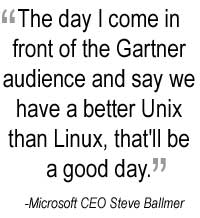Ballmer: Microsoft to go after Linux strongholds

During Wednesday's main attraction here at Gartner Symposium in Orlando, FL -- a keynote Q&A session with Microsoft's Steve Ballmer -- the CEO of the Redmond, WA-based company gave some details on how Microsoft plans to win the hearts and minds of buyers who are thinking about going with Linux instead of Windows. A copy of the entire 45 minute interview can be downloaded (it's 21 MB) by clicking here.

To turn that trend around, Ballmer said their are four specific Linux strongholds that Microsoft is focusing it's attention on. Said Ballmer:
I think we have four big opportunities to take business from Linux and we will. And again, why would we take it. Because people will take a look at the tools and the technologies we put in the marketplace and decide that they deliver better results at a lower cost. What's the first? High performance clustering. High performance clusters is a thing that has been a Linux stronghold. It's about 20 percent of all Linux systems. We're coming out with a compute cluster edition of Windows Server. We're coming out with new development tools that help people write applications that make sense in that kind of scientific computing environment. We see a great opportunity to thrive with innovation versus open source, verus Linux. Same thing in Web hosting. With the new work we have coming out in Visual Studio and ASP.NET, we see a great opportunity to offer hosters -- lightweight hosters -- a better solution than Linux. And that's been a traditional stronghold. Same thing in server appliances
After discussing server clustering, Web hosting, and server appliances, Ballmer was cut off by the interviewees before he could identify the fourth. But my guess is that, given the way Ballmer emphasized Software as a Service (SaaS) as a core theme for all the work that's taking place at Microsoft right now, the fourth stronghold of Linux that Microsoft wants is the SaaS stronghold where Linux is the operating system behind a Java-based application server technology. Application servers typically live at the heart of any SaaS offering and whereas Java is primarily the SaaS middleware technology that's associated with the various "IXes," .NET serves in that role for Windows.
Ballmer's comment about going after Web hosters with a lightweight offering is perhaps a big concession that its Windows Server products may include far too many accoutrements -- often referred to as bloat -- to service the basic needs of many server environments. Linux has served Web hosters well in this respect because of how those in charge of deployment are free to make the operating system as mean and lean as they'd like, stripping out all sorts of componentry whose Windows counterparts (if they exist) can't so easily be removed from Microsoft's operating systems. Whereas Microsoft may offer a lightweight version of Windows Server for Web hosters, Ballmer stopped short of saying that customers would have the same flexibility to pare down the OS to just those components that people might really want.
Breaking into the appliance business where the operating system is transparently embedded in such a way that end users never really get access to it may prove to be an even more difficult challenge for Microsoft. The reason? Licensing. If end users are building turnkey appliances the way ZDNet reader Miles Wade is for his company, then sure, Microsoft has an opportunity. Particularly when that user wants support. But for 99 percent of the appliances out there -- most of which are commercially available as turnkey products -- the embedded operating system that's behind the scenes is some free version of Linux or Unix that the vendor isn't paying a dime for. Unless Microsoft plans to give away it's embedded version of Windows, I don't see how Microsoft can compete here.
Finally, compute clusters are a new enough business that Microsoft may have a shot if it can convince the developers of the primarily scientific applications that run on them to port their work over to Windows. But, here again, the whole idea behind clusters (as well as grids), is often to parcel out workloads to the cheapest commodity hardware money can buy. The reason Microsoft has a shot here is that there are plenty of cluster users that are probably willing to pay a premium if they're guaranteed a high level of support. But in many of these cluster and grid scenarios -- scenarios that often involve home grown setups with versions of Linux that aren't supported by any of the various Linux distributors -- the people running them are again not incurring any licensing costs on the operating system.
Saying "That means we still have work to do," Ballmer knows he's got a long roe row to hoe. "The day I come in front of the Gartner audience and say we have a better Unix than Linux, that'll be a good day."
For Microsoft employees, that sounds like marching orders to me.